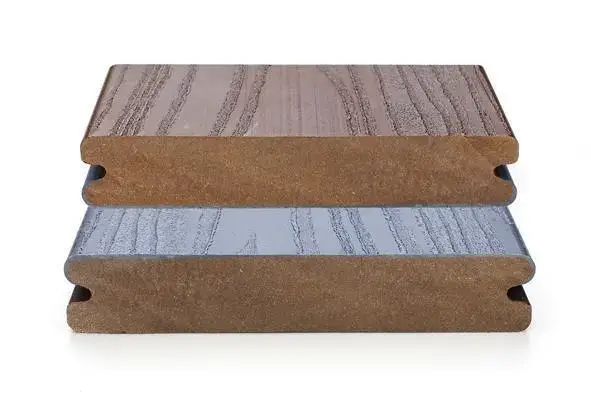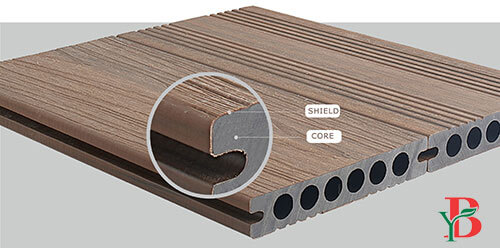Composite and PVC decking are both popular choices for homeowners who are looking for a low-maintenance, durable, and attractive decking material. However, there are some key differences between the two materials that may make one a better choice for your specific needs.
Composite decking is made from a mixture of wood fibers and plastic. It is a good choice for homeowners who want the look of wood without the hassle of maintenance. Composite decking is resistant to mold, mildew, and rot, and it does not require staining or sealing.
- Early Uncapped Composite Decking (1995-2008)
- Capped Composite Decking (2008 – Present day) —Capped decking offers extra protection in the form of a hard outer shell, which provides added protection against the elements and everyday living.
PVC decking is made from a completely synthetic material, which is 100% plastic. It is the most durable type of decking available, and it is also the most low-maintenance. PVC decking is completely resistant to mold, mildew, rot, and insects. It also does not require staining or sealing. However, PVC decking can be more expensive than composite decking.
- PVC Decking (2009 – Present day)
Composite Vs. PVC Decking
PVC Decking: A Closer Look

Pros:
- Longevity stands out, supported much longer year warranty than composite decking.
- Entirely synthetic, resisting rot and weathering, ensuring an enduring deck structure.
- Exhibits water and mold resistance, advocating for hassle-free maintenance.
- Easy to install due to its lightweight nature.
- Offers a versatile array of colors and styles.
Cons:
- Initial costs are higher than composite decking, affecting the upfront investment.
- Carries a visibly synthetic appearance, which might be a decisive factor for some.
- Can become hotter to the touch under direct sunlight.
Composite Decking: Assessing the Alternatives

Pros:
- Boasts a durable lifespan.
- Crafted from recycled materials, adhering to sustainability principles.
- Features water and mold resistance when fully capped with high-performance technology.
- Affordability shines through with a more budget-friendly initial cost.
- Mimics the appealing look of natural wood.
Cons:
- Tends to expand and contract slightly due to temperature changes, potentially impacting structural stability.
- Slightly heavier than PVC decking, affecting installation dynamics.
- May necessitate slightly more maintenance compared to PVC decking.
Here is a table comparing the key differences between composite and PVC decking:
| Characteristic | Composite decking | PVC decking |
| Material | Recycled wood fibers and recycled plastic | Entirely synthetic material |
| Durability | Very durable | Extremely durable |
| Maintenance | Very low-maintenance, does not require staining or sealing | No maintenance required |
| Resistance to rot, and insects | Yes | Yes |
| Resistance to mold, mildew | Yes (fully capped) | Yes |
| Appearance | Available in a variety of colors and styles, Resembles natural wood | Available in a variety of colors and styles, but may not have the same natural look as wood |
| Cost | Less expensive than PVC decking | More expensive than composite decking |
Composite Vs. PVC – Which is Better?
Here are some additional factors to consider when choosing between composite and PVC decking:
- Authentic looking
Composite decking looks more natural due to containing wood fibers. It is more authentic looking than PVC.
- Slip resistance
Composite decking with wood embossed texturing has a better slip resistance than PVC. It is an ideal choice if your deck surrounds a pool or hot tub, or is in a rainy region, where its surface might be frequently wet and a potential hazard for kids and guests.
- Temperature stability
When the temperature changes suddenly, PVC decking can expand and contract. This makes the structure less stable over time. But because the wood fibers in composite decking make it more rigid, it won’t expand and contract as easily as plastic in direct sunlight.
- Mold resistance
Because composite still container wood fiber, it is not good at mold resistance, so the Capped Composite Decking emerged. The capped composite with the outer shield makes it better resistant to mold and mildew. PVC decking is made by 100% plastic, so its mold resistance is better than composite decking.
- Pets
PVC decking is more resistant to scratches and stains from pets than composite decking. If you have pets, PVC decking may be a better choice.
- Climate
PVC decking is more resistant to extreme temperatures and moisture than composite decking. If you live in a climate with hot summers and cold winters, PVC decking may be a better choice.
- Foot traffic
PVC decking is better able to withstand heavy foot traffic than composite decking. If you have a large family or entertain frequently, PVC decking may be a better choice.
Ultimately, the decision between composite and PVC decking revolves around individual budget considerations, design preferences, and specific needs. For a longer lifespan and a more natural appearance, composite decking might align better, whereas those seeking entirely synthetic, low-maintenance options may find PVC decking more suitable.
For in-depth comparisons and insights, refer to the following sources:
- Rings End: PVC Decking vs. Composite
- TimberTech: PVC vs. Composite Decking
- Decks.com: Differences Between PVC & Composite Decking
Bongywood Wood Plastic Composite
Guangdong Bangying New Building Materials Co., Ltd. is a professional manufacturer specializing in the R&D, production, and sales of WPC (Wood Plastic Composite) materials, our products include composite decking, capped composite decking, WPC Wall Panel, WPC Railing & Fencing, WPC Pergola & Gazebo, WPC Chairs & Bench, WPC Flower Planter Pots, etc.
Leave a Reply

